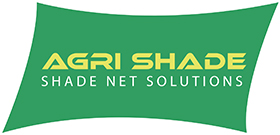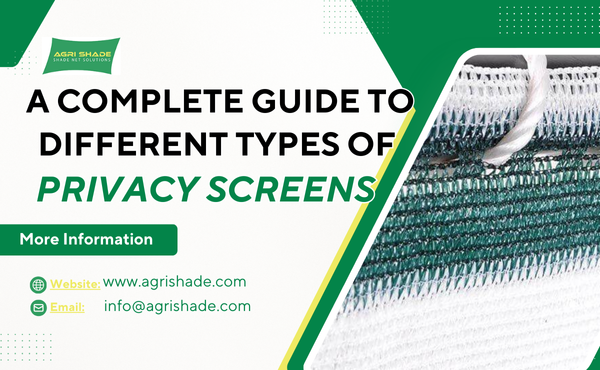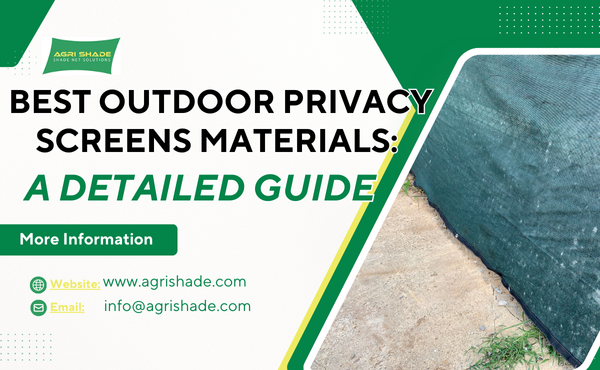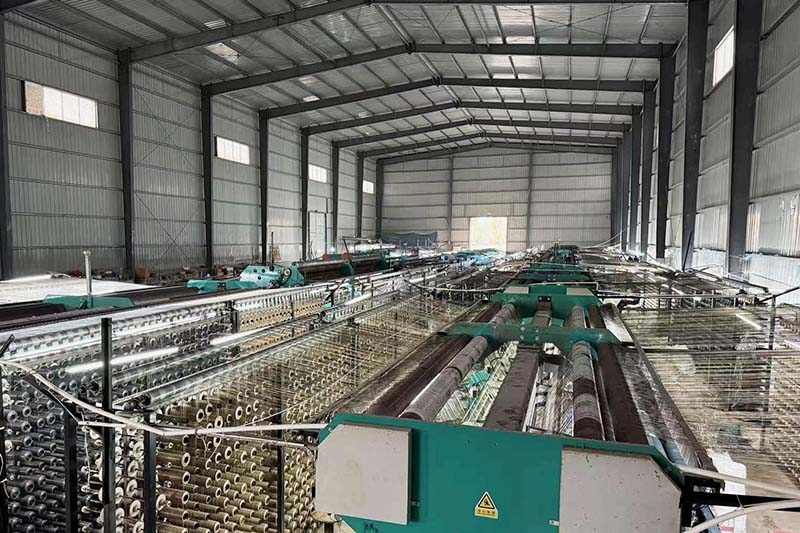Greenhouse shade netting protects plants from excessive sunlight, but over time it can tear or wear out, reducing its effectiveness. Knowing how to repair greenhouse shade netting quickly saves you money and keeps your crops healthy. In this guide, you’ll learn step-by-step methods to fix common damages, the tools you need, and tips to extend your netting’s lifespan.
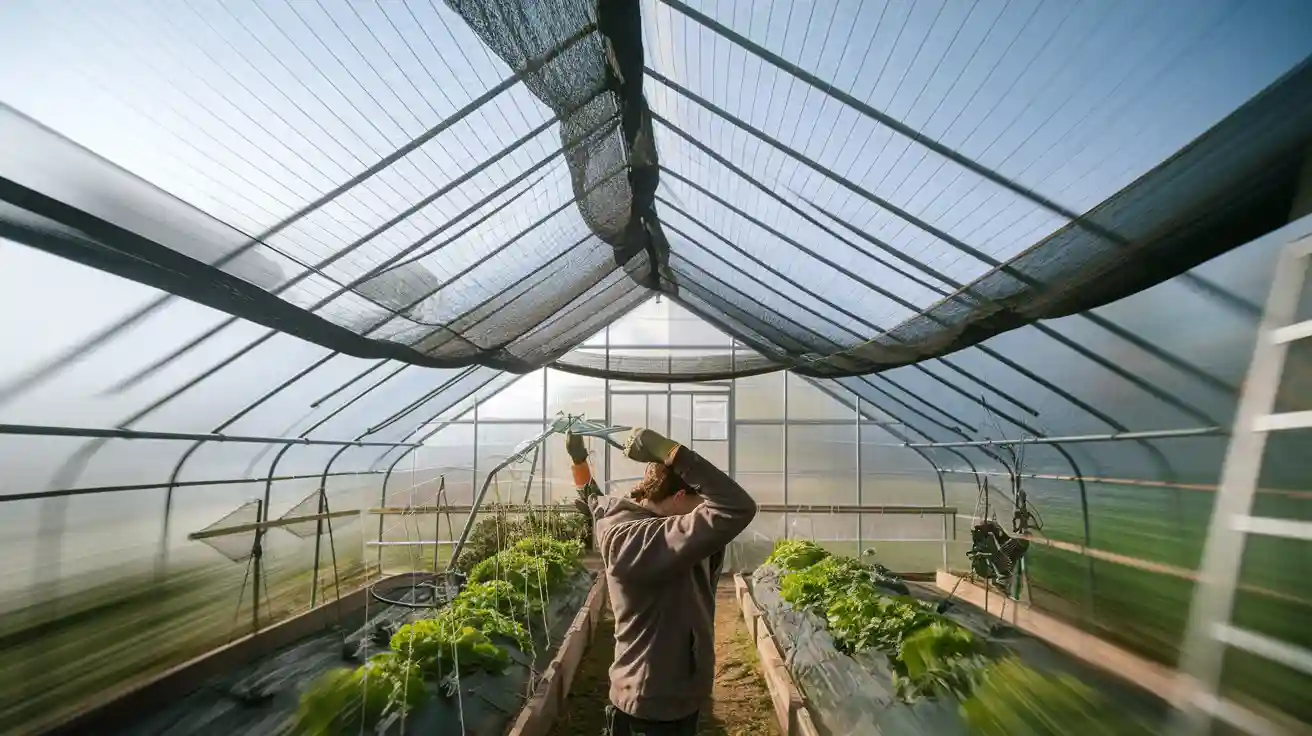
Greenhouse Shade Netting Problems
Tears and Holes
Tears and holes often appear in shade cloth after exposure to wind, sun, or sharp objects. These damages reduce the effectiveness of shading and can let in too much sunlight. When holes form, plants may suffer from heat stress or leaf burn.
Gardeners should inspect shading systems regularly for small rips. Early detection helps prevent larger problems. Even a small tear in shade cloth can grow quickly if left untreated.
Some common causes of tears include strong winds, animals, or accidental contact with tools. Shade cloth with tears cannot provide even shading, which may harm sensitive crops. Using repair tape or patches can restore the function of shading systems.
Loose or Sagging Netting
Loose or sagging netting creates uneven shading and can lead to hot spots inside the greenhouse. When shade cloth sags, it may touch plants and cause physical damage. Properly tensioned greenhouse shade netting ensures consistent shading across all areas.
Shading systems work best when the shade cloth stays tight and secure. Clips, bungee cords, or hooks help keep the netting in place. If netting becomes loose, wind can lift it and cause further damage.
Gardeners should check the attachment points of shading systems often. Replacing worn fasteners or adjusting tension can prevent sagging. Well-maintained greenhouse shade netting supports healthy plant growth by providing reliable shading.
Tools and Materials for Shade Cloth Repair
Clips and Fasteners
Clips and fasteners play a key role in securing shade nets to greenhouse frames. Gardeners often use plastic or metal clips to attach shade cloth tightly. These clips prevent the shade cloth from slipping or flapping in the wind.
Many types of clips work well with shade cloth. Some clips snap directly onto the fabric, while others grip both the shade cloth and the support wire. Using the right clip helps keep the shade cloth flat and smooth.
Fasteners like cable ties or snap grommets also help attach shade cloth to poles or wires. These fasteners make it easy to remove or adjust the shade cloth when needed. Properly installed fasteners reduce the risk of tears in the shade cloth.
A table below shows common fasteners for shade cloth:
| Fastener Type | Best Use |
|---|---|
| Plastic Clips | Quick attachment |
| Metal Clips | Heavy-duty support |
| Cable Ties | Temporary fixes |
| Snap Grommets | Adjustable positions |
Bungee Cords and Hooks
Bungee cords and hooks offer flexible support for shade cloth. Gardeners use bungee cords to stretch the shade cloth and keep it under tension. This method helps prevent sagging and keeps the shade cloth in place during strong winds.
Hooks allow for easy removal and reinstallation of shade cloth. Many gardeners attach hooks to greenhouse frames and loop bungee cords through the shade cloth. This setup makes it simple to adjust the shade cloth as sunlight changes.
Bungee cords and hooks work well for both inside and outside installations. They help maintain even tension across the shade cloth, which protects plants from uneven sunlight. Using these tools extends the life of the shade cloth and improves greenhouse performance.
Step by Step to Repair Greenhouse Shade Netting
Cleaning and Preparation
Gardeners start by removing dust and debris from the shade cloth. Clean surfaces help patches stick better and prevent mold. Use a soft brush or hose to wash the fabric gently.
Inspect the entire area for weak spots or frayed edges. Preparation ensures that repairs last longer and shading remains effective.
Patching Small Holes
Small holes in shade cloth can appear after storms or from sharp objects. Quick action prevents these holes from growing larger. Use repair tape or fabric patches designed for outdoor use.
Follow these steps for patching:
- Cut a patch slightly larger than the hole.
- Place the patch over the damaged area.
- Press firmly to secure the patch.
Patching small holes helps maintain even shading and protects plants from excess sunlight. Regular patching extends the life of the shading system.
Repairing Large Tears
Large tears in shade cloth require stronger repair methods. Overlapping fabric and using heavy-duty thread or zip ties can restore the structure. Some gardeners sew the edges together with UV-resistant thread.
For best results:
- Align the torn edges.
- Overlap the fabric by at least one inch.
- Stitch or tie the edges securely.
Large repairs keep the shading system stable and prevent further damage. Strong repairs also help the shade cloth resist wind and weather.
Securing with Clips or Bungees
Proper tensioning is key for effective shading. Loose shade cloth can sag or flap in the wind, causing uneven shading and possible damage. Use clips, bungee cords, or hooks to keep the fabric tight.
A table below shows common securing tools:
| Tool | Best Use |
|---|---|
| Shade cloth clips | Quick, strong hold |
| Bungee cords | Flexible tension |
| Hooks | Easy removal |
Gardeners attach shade cloth to the greenhouse frame using these tools. Clips work well for permanent setups. Bungee cords allow for easy adjustments.
Both inside and outside installations have benefits. Inside installations protect the shade cloth from weather, while outside installations block more sunlight before it enters the greenhouse. Choose the method that fits the climate and plant needs.
Effective shading methods depend on proper installation and regular maintenance. Good shade cloth installation keeps the fabric secure and ensures plants receive the right amount of light. By using the right shading methods, gardeners protect crops and improve greenhouse performance.
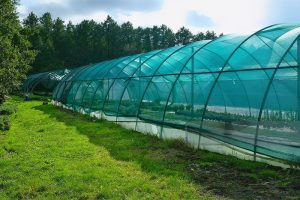
Shading Maintenance Tips
Regular Inspections
Gardeners should check shading systems often to catch problems early. Tears, loose spots, or worn fasteners can weaken shading. Regular inspections help keep shade cloth in good condition and ensure even shading for all plants.
A simple checklist for inspections includes:
- Look for holes or rips in the shade cloth.
- Check all fasteners and clips for damage.
- Make sure the shading stays tight and secure.
Cleaning Methods
Dust and debris can build up on shade cloth and reduce the effectiveness of shading. Clean shade cloth allows more even light and better airflow. Gardeners should clean shading systems at least once each season.
Use these steps for cleaning:
- Remove loose dirt with a soft brush.
- Rinse the shade cloth with water from a hose.
- Let the fabric dry before reattaching it to the frame.
Some gardeners use mild soap for stubborn stains. Avoid harsh chemicals, as they can damage the fabric and shorten the life of shading systems.
Seasonal Adjustments
Different seasons require changes in shading methods. In summer, gardeners may need to add extra shade cloth to protect plants from intense sunlight. During cooler months, they might remove some shading to let in more light.
A table below shows common seasonal adjustments:
| Season | Shading Action |
|---|---|
| Spring | Install light shading |
| Summer | Increase shading |
| Fall | Reduce shading |
| Winter | Remove most shading |
Adjusting shading systems helps maintain the right environment for plant growth. By changing shading methods, gardeners can shade a greenhouse effectively all year.
Repair or Replace Greenhouse Shade Netting
Lifespan Assessment
Greenhouse shade netting does not last forever. Most gardeners notice signs of wear after several seasons of use. Sunlight, wind, and rain can weaken the material. Regular inspections help identify when shading no longer works well. Tears, fading, or brittleness show that the netting may need replacement. If shading fails to block enough sunlight, plants can suffer. Some gardeners keep a record of when they install new netting. This habit helps track the lifespan of shading and plan for future changes.
A table below shows common signs that indicate replacement:
| Sign of Wear | Impact on Shading |
|---|---|
| Large holes | Uneven shading |
| Faded color | Reduced sunlight block |
| Brittle texture | Easy tearing |
Cost Considerations
Repairing greenhouse shade netting often costs less than buying new material. Small holes or loose areas can be fixed with patches or clips. Gardeners save money by repairing shading early. However, frequent repairs may add up over time. When the cost of repairs approaches the price of new netting, replacement makes sense.
Some gardeners compare the price of repair kits with the cost of new shading. They also consider the time needed for repairs. Investing in quality shading can reduce long-term expenses. Proper care and regular cleaning help extend the life of shading and delay replacement.
Conclusion
Managing greenhouse shade netting requires regular inspection, timely repairs, and proper tensioning to maintain consistent shading and protect your plants. Watch closely for tears and holes, patch small damages quickly, and use clips or bungee cords to prevent sagging. Clean the shade cloth periodically and adjust shading based on seasonal needs to optimize plant health.
Over time, monitor signs of wear like fading or brittleness to decide when replacement is more cost-effective than continuous repairs. Taking these practical steps helps ensure your greenhouse stays efficient and your crops thrive.
